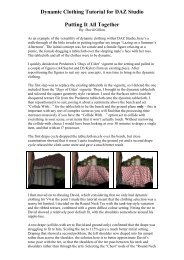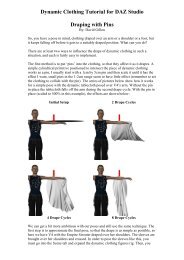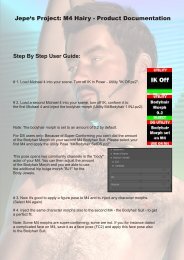Documentation for the use of the Advanced Ambient Light ... - Daz 3D
Documentation for the use of the Advanced Ambient Light ... - Daz 3D
Documentation for the use of the Advanced Ambient Light ... - Daz 3D
You also want an ePaper? Increase the reach of your titles
YUMPU automatically turns print PDFs into web optimized ePapers that Google loves.
It is common <strong>for</strong> shaders, lights or <strong>the</strong> scene file to adjust <strong>the</strong> surface normals so that <strong>the</strong>y never face awayfrom <strong>the</strong> camera.For instance, if you place a camera and a standard DAZ Studio light inside <strong>of</strong> a large cube primitive youwould see light hitting <strong>the</strong> walls <strong>of</strong> <strong>the</strong> box beca<strong>use</strong> <strong>the</strong> renderer is flipping <strong>the</strong> (normally outward facing)polygon normals to face inward towards <strong>the</strong> camera or "Face Forward".Face Forward is generally a good setting, however it produces poor results when baking illumination mapsbeca<strong>use</strong> <strong>the</strong> light will be illuminating <strong>the</strong> wrong sides <strong>of</strong> any flipped faces.In addition to its <strong>use</strong> in illumination baking, <strong>the</strong> Surface Normal setting is usually better <strong>for</strong> calculatingsubsurface scattering which reads <strong>the</strong> surface normal direction to determine were light enters and exits anobject. Face Forward will yield incorrect, though possibly acceptable, results on surfaces with SSS.<strong>Light</strong>ing ControlThe features available under <strong>the</strong> <strong>Light</strong>ing Control group allow you to set how <strong>the</strong> light behaves <strong>for</strong> different







